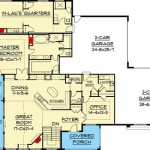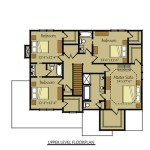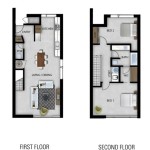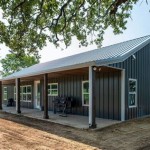Harmonizing Home Plans with Outdoor Living Spaces
Integrating outdoor living spaces into home plans has become increasingly popular. This trend reflects a desire to extend the functionality and aesthetic appeal of a home beyond its interior walls. Effective outdoor living design contributes significantly to a home's value, enhances lifestyle, and fosters a connection with nature. Home plans that thoughtfully incorporate outdoor elements result in a seamless transition between indoor and outdoor environments.
The process of incorporating outdoor living spaces into home plans requires careful consideration of various factors, including climate, site conditions, lifestyle preferences, and budgetary constraints. A well-designed outdoor space is more than just an afterthought; it is an integral part of the overall home design. It should complement the architectural style of the house and function as an extension of the interior living areas.
Successful integration involves planning for various outdoor zones, each with a specific purpose. These zones may include areas for dining, relaxation, cooking, playing, and gardening. Prioritizing these zones will ensure that the outdoor space is both practical and enjoyable for the homeowners.
Optimizing Space and Functionality
Efficient space utilization is paramount when designing outdoor living areas. The size and configuration of the outdoor space should be proportional to the size of the house and the needs of the occupants. A large backyard does not automatically equate to a well-designed outdoor living area; careful planning is essential to maximize its potential.
Consider the flow of traffic between the indoor and outdoor spaces. Direct access from key living areas, such as the kitchen, living room, and dining room, is crucial to facilitate effortless movement and enhance the usability of the outdoor space. Wide doors or sliding glass doors can create a seamless transition between the interior and exterior.
Multifunctional spaces are particularly valuable in smaller outdoor areas. For example, a dining table can also serve as a workspace or a crafting area. Built-in seating can offer both comfort and storage. The thoughtful incorporation of multifunctional elements will maximize the usability of the space without sacrificing its aesthetic appeal.
Landscaping plays a vital role in defining and enhancing outdoor living spaces. Trees, shrubs, and flowers can create privacy, provide shade, and add visual interest. The selection of plants should be carefully considered, taking into account climate conditions, soil type, and maintenance requirements. Native plants are often a good choice, as they are well-adapted to the local environment and require less water and maintenance.
Hardscaping elements, such as patios, walkways, and decks, are also essential components of outdoor living design. The materials used for these elements should be durable, weather-resistant, and aesthetically pleasing. Natural stone, pavers, and composite decking are popular choices for outdoor surfaces.
Outdoor lighting is often overlooked but is a crucial element for extending the usability of the space into the evening hours. Well-placed lighting can enhance safety, create ambiance, and highlight architectural features. Consider using a combination of ambient lighting, task lighting, and accent lighting to create a layered effect.
Water features, such as fountains, ponds, and waterfalls, can add a sense of tranquility and create a focal point in the outdoor space. The sound of water can also help to mask unwanted noise from traffic or neighbors. Water features require maintenance to prevent algae growth and ensure proper functioning.
Incorporating Climate-Appropriate Design
Climate is a critical factor to consider when designing outdoor living spaces. A design that works well in a warm, sunny climate may not be suitable for a cold, rainy climate. The goal is to create an outdoor space that can be enjoyed year-round, regardless of the weather conditions.
In hot climates, shade is essential. Trees, pergolas, awnings, and shade sails can provide protection from the sun and reduce the temperature of the outdoor space. Consider the orientation of the house and the position of the sun when planning for shade. Strategically placed trees can provide shade during the hottest part of the day, while allowing sunlight to penetrate during the cooler months.
In cold climates, wind protection is important. Windbreaks, such as hedges, fences, and walls, can reduce the wind chill factor and make the outdoor space more comfortable. Consider the prevailing wind direction when planning for wind protection.
Outdoor heating systems, such as fireplaces, fire pits, and patio heaters, can extend the usability of the outdoor space into the colder months. Fireplaces and fire pits create a cozy atmosphere and provide a focal point for gatherings. Patio heaters are a more portable option and can be used to warm specific areas.
In rainy climates, covered areas are essential. Porches, verandas, and gazebos provide protection from the rain and allow you to enjoy the outdoor space even when the weather is less than ideal. Consider the roof pitch and drainage system to ensure that water flows away from the house and does not accumulate in the outdoor area.
Proper drainage is also important in any climate to prevent water from pooling and causing damage to the outdoor space. Grading the land away from the house and installing drainage systems, such as French drains, can help to manage rainwater runoff.
Materials used in outdoor construction should be chosen based on their ability to withstand the local climate. For example, in coastal areas, materials should be resistant to salt air and corrosion. In areas with extreme temperature fluctuations, materials should be able to expand and contract without cracking or warping.
Enhancing Lifestyle and Leisure
The ultimate purpose of an outdoor living space is to enhance lifestyle and provide opportunities for leisure activities. The design should reflect the interests and preferences of the homeowners and cater to their specific needs.
Outdoor kitchens are becoming increasingly popular, allowing homeowners to prepare and cook meals outdoors. A basic outdoor kitchen may include a grill, a countertop, and a sink. More elaborate outdoor kitchens may include a refrigerator, a pizza oven, and a bar. Consider the placement of the outdoor kitchen in relation to the indoor kitchen to facilitate easy access and minimize travel time.
Outdoor dining areas provide a space for enjoying meals with family and friends. The size of the dining area should be proportional to the number of people who will typically be using it. Consider using durable, weather-resistant furniture that is easy to clean.
Outdoor living rooms offer a comfortable and relaxing space for lounging and socializing. Comfortable seating, such as sofas, chairs, and hammocks, can create a welcoming atmosphere. Consider adding an outdoor television or sound system to enhance the entertainment experience.
Swimming pools and hot tubs provide opportunities for recreation and relaxation. The placement of the pool or hot tub should be carefully considered, taking into account privacy, sun exposure, and safety. Fencing is essential to prevent accidents, especially if there are young children in the household.
Gardens provide a connection with nature and offer opportunities for gardening and landscaping. A well-designed garden can enhance the aesthetic appeal of the outdoor space and provide a source of fresh herbs, vegetables, and flowers. Consider using raised garden beds to make gardening easier and more accessible.
Play areas for children can encourage outdoor activity and provide a safe and supervised space for play. Swingsets, slides, and sandboxes are popular choices for play areas. Consider using soft surfaces, such as rubber mulch or artificial turf, to cushion falls.
Pet-friendly features can make the outdoor space more enjoyable for pets. Fenced-in areas, dog houses, and water bowls can help to keep pets safe and comfortable. Consider using pet-friendly landscaping materials that are non-toxic and durable.
Ultimately, the success of an outdoor living space depends on its ability to meet the specific needs and desires of the homeowners. By considering climate, functionality, and lifestyle, it is possible to create an outdoor space that is both beautiful and functional, and that enhances the quality of life for the entire family.

Outdoor Living Spaces

12 Floor Plans With Indoor Outdoor Living Houseplans Blog Com

Plan 871012jen Luxury Modern Home With Expansive Outdoor Living Spaces And Pool Concept

Best Outdoor Living Space Ideas For Your Home Frank Betz

12 Floor Plans With Indoor Outdoor Living Houseplans Blog Com

House Plans Outdoor Living Spaces Popular Feature In New Home Designs The Designers

Plan 8292

Plan 75994 Single Story Mediterranean Home With Large Outd

House Plans Outdoor Living Spaces Popular Feature In New Home Designs The Designers

House Plans With Outdoor Living Space And Rear Porch








